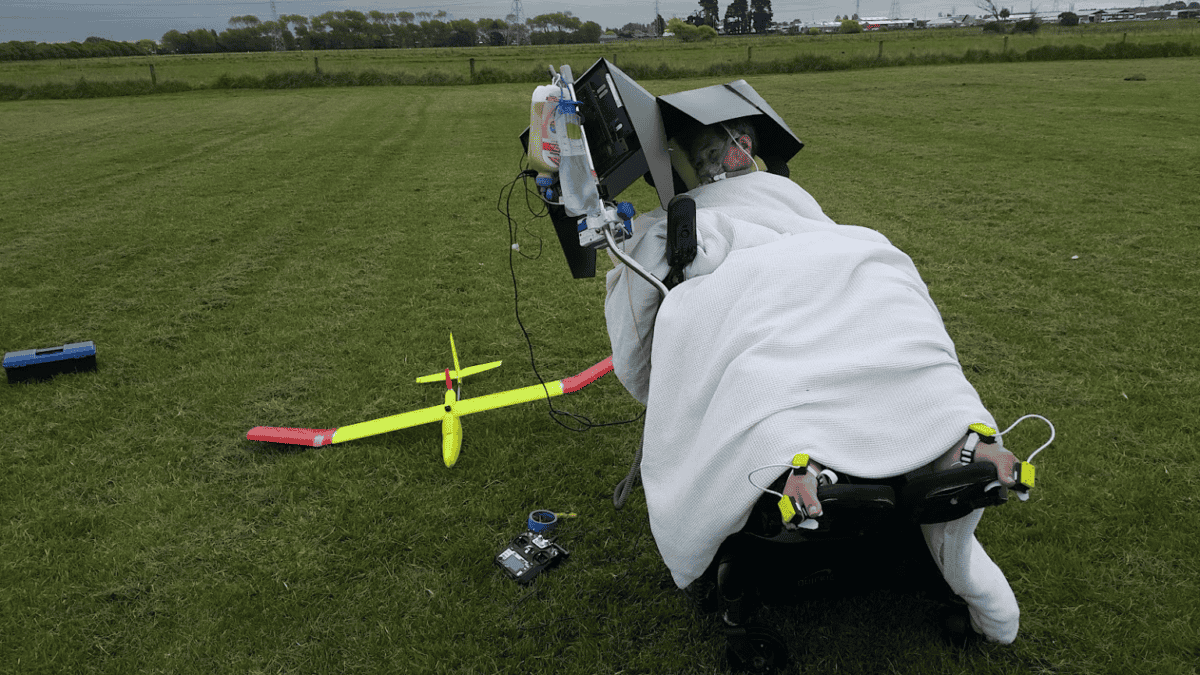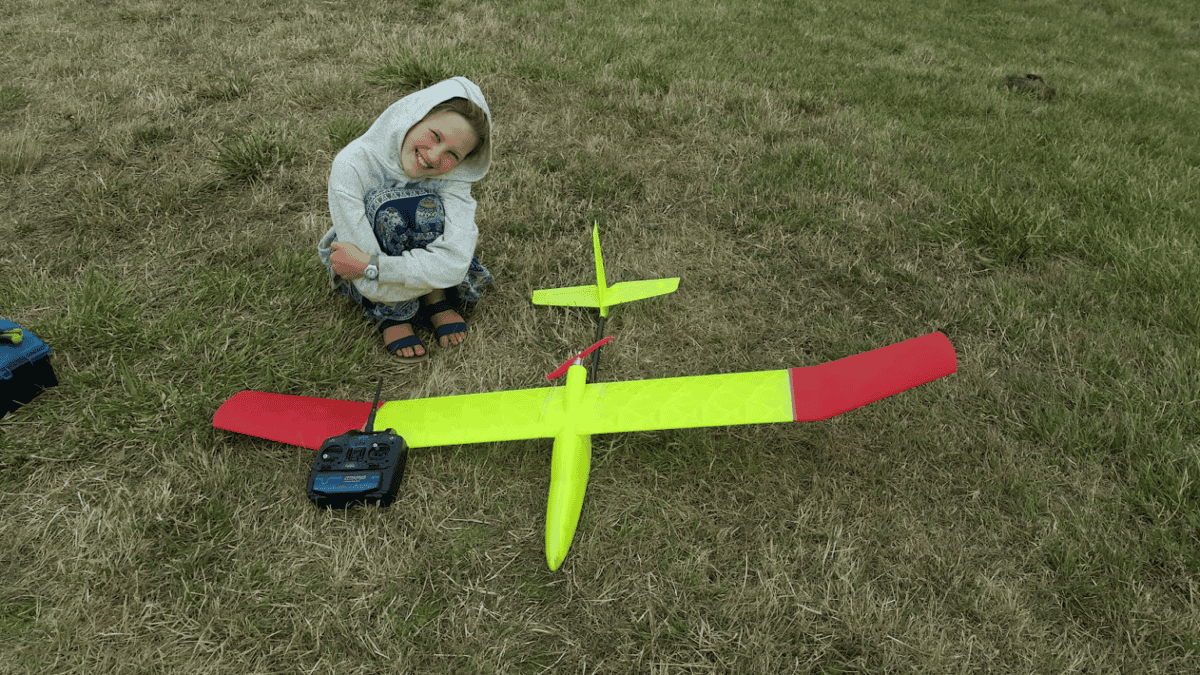Living with purpose: Brent’s journey with MND
Community, Personal Stories
17 December 2024

Canterbury’s Brent Thompson was diagnosed with MND in August 2013, which he describes as “a wrecking ball through our whole world!” He and his wife Jess had a nine-month old baby girl, and were in the final stages of designing their dream home in Rangiora. Brent also ran his own business, designing and manufacturing aircraft propellers. It was a small business, and very hands on, which meant as his condition advanced, he couldn't continue with declining physical ability.
This is Brent’s remarkable story about some of the projects he has embarked on since his diagnosis to keep himself busy and focused.
Brent’s original story has been edited for flow and length.
I was diagnosed in August 2013, so it's been a bit over 11 years. Our first child was just 9 months old, and we were in the engineering stages of planning our dream home, on a property near Rangiora. We had planned to build the house ourselves, but once I was diagnosed, we realised that would be impossible.
The diagnosis was like a wrecking ball through our whole world! I couldn't think straight, and couldn't focus on anything at first. I was running a business designing and manufacturing aircraft propellers, but it was a small business, and very hands on, which meant I couldn't continue with my declining physical ability. Luckily, I found a buyer, and the business is still running under a new name.
Then I started working on some bucket list items. I'd been working on a private pilot's license to allow me to fly types of aerobatic aircraft which weren't covered by my microlight certificate. Initially, I thought that was the end of that, but after a short battle with the Civil Aviation Authority, they allowed me to keep my medical certificate for a while, subject to monthly assessments and a raft of restrictions. I resumed training, both for my licence, and for competition aerobatic flying, and focused on that for the next few months. I entered my first aerobatic competition at the regional flying competitions and won my class, with a safety pilot in the passenger seat because I didn't yet have a licence. That got me through to the 2014 National Championships. I passed my license test in between, and placed 2nd in the Nationals (the class excluded professional pilots), and was chosen to represent New Zealand in the international Wings competition in Australia. Unfortunately, the weather stopped the Aerobatic part from going ahead. That was a huge disappointment, but it was amazing to be chosen!
At the time of diagnosis, I had a couple of major projects on the go, including an aeroplane rebuild, and an electric car build (both pictured).


After the Aerobatics contest, friends and family, including my mum, stepped in to help with the projects, which helped me speed up the progress. At first, I could still do a lot of the work myself, but as time went by, my limbs weakened and I became more and more dependent on others to do the physical work. I'm so grateful to all the people who gave their time to help!
Meanwhile, we sold the property and moved to a more manageable and more accessible home in Christchurch. We finished the car in September of 2014, and I was still able to drive it for a few months. It remains my wife, Jess's primary runabout. The plane took the longest, and was finished in 2017, by which time I was Bipap dependent and using a head mouse controlled computer to talk. I could barely drive my own wheelchair!

Losing the ability to use my hands, and becoming fully dependent on other people was really hard to deal with, especially for personal care. At first, I didn't want to accept outside help, so all the burden fell on Jess, who was also trying to raise a toddler and manage the clearing out of our large shed full of stuff at our old property. That put a significant strain on our relationship, and if there's one thing I could change, looking back to the early years, it would be accepting help with my care earlier.
Progression of my MND over the first five years seemed reasonably normal by MND standards. I saw several people in our local support group pass away, who seemed less advanced than I was, and it always felt like I might survive until next winter, if I was lucky. By late 2018, I'd lost so much strength in my neck that I couldn't support my head well enough to use the head mouse, and I trialled a Tobii eye gaze, and a Grid Pad with eye tracking camera, before settling on the Grid Pad. That opened up a new world for me, as suddenly, computer access and communication became a lot easier.
Since then, I've noticed very little change in my condition, and with that stability, came a chance to get used to my situation, and settle into a routine that worked. I also started to think of myself less as someone who was dying, and more as someone living with an illness. I started thinking longer term, did some online study in 2020, and took up a little voluntary work as a result.
We started entertaining the idea of having a second child, and in 2022, our son, Cameron was born. I live for my family above all. Jess works incredibly hard to keep our family together, while looking after me and raising two children! I consider myself extremely lucky to have a loving family who support me and give me reason to keep fighting, as well as a fantastic team of carers and friends.

With everything that was going on in my life, I certainly wasn't bored! But I missed being able to design and make things. In late 2021, I bought a 3D printer, giving myself a way to create again, which was fantastic! I had to learn 3D modelling on the computer, and tried a few different programs, but most of them required accurate use of a mouse, which I couldn't do with my eye tracking system. I settled on a free modelling program called openscad, in which the model is defined by writing code, similar to the language of computer programming. Having never done anything like that before (I had very limited computer literacy), it was a steep learning curve to learn the language and how to create the complex shapes I wanted, but it appealed because I could do it all with an eye tracking keyboard.
With my history of aviation, designing a model aircraft to be 3D printed seemed like a suitably interesting and challenging project. I designed the components on openscad, and printed them on the 3D printer. Then my friend, Barry, who spends a day with me once a week, helped me assemble it. The design was challenging, because plastic has poor structural properties compared to more conventional model building materials such as balsa wood, and 3D printed plastic is even worse. Keeping the weight sufficiently low, while retaining adequate strength was difficult. But we got there, and it flew, but it was frustrating not to be able to take the controls. Other 3D printed creations include a mounting system to mount my BiPAP machine on my wheelchair, in a way that enables it to be easily transferred from wheelchair to commode.
In the last couple of years, I've started entertaining the idea of being able to drive my wheelchair again, which would make a huge difference to my freedom. Eye controlled systems exist, but are incredibly expensive, and struggle in the bright light outdoors. I was told that a system is being trialled in New Zealand, but the chances of being funded for it were about zero. A friend of mine, Terry Johnson and I were talking about different ideas to control my wheelchair, and I described the different movements I could still manage which might be useful for control, which included the ability to slightly waggle my feet and toes. Terry had a great idea to develop a ‘computer joystick’ type control system, using sensors which could strap to any part of my body with movement.
Terry started out by making a pair of sensors for my feet that enabled me to scroll up and down on my computer. After that came a two-axis joystick control, with sensors on my toes and feet, which enabled me to operate a flight simulator on the computer, and also manipulate a mouse cursor. The feet worked well, but I struggled to achieve accurate movement with my toes, which often spasmed, resulting in uncommanded control inputs. After that, we looked for other places where I could still manage a slight movement, and added sensors for my waist and head, allowing a greater range of control inputs. I used it first for a flight simulator program on the computer, which is great fun, of course, having previously been a recreational pilot. Then I asked Terry if the system could be made to connect to a radio transmitter for controlling model aircraft. Once again, Terry came through and developed a system, and it works. The number of hours he's put into this project have been huge! The system is called “Aerotoe”, and Terry hopes it will benefit many other people with motor neurone disease and similar conditions.


Unfortunately, the first time I tried to use it with my own model, I crashed, but it was an exciting step! I'm currently in the process of making some design alterations for a Mk-2 version of the aircraft, and getting more practise in with the simulator. I still dream of being able to drive my wheelchair, but one thing at a time, and these steps are definitely in the right direction!
The things that keep me going are cuddles and time with my family, and the joy of watching our children grow up, always having some kind of project on the go, or something to work towards, and maintaining a sense of purpose.
My advice to anyone who has MND is to focus on the things you can still do, and pleasures that can still be enjoyed, rather than what has been lost. Find things to work towards and keep your mind busy, and look after your loved ones and the people who look after you. Also, don't be afraid to get outside help with your cares. One of the biggest challenges for a couple is figuring out how to maintain a healthy couple's relationship, instead of simply becoming nurse and patient. This requires constant work on both sides, and sometimes, difficult conversations.



